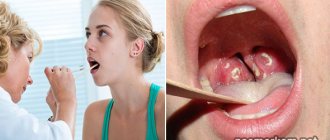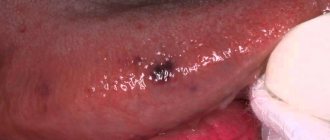Atrophic pharyngitis is a chronic inflammatory disease of the pharynx, which leads to atrophic changes in its mucosa. Mucosal cells lose their functions and gradually begin to be replaced by epithelial tissues. The disease is regarded as precancerous and requires special attention. Leaving the pathology without treatment is strictly prohibited, as this greatly increases the risk of pharyngeal cancer.
With atrophic pharyngitis, degradation (death) of mucosal cells occurs, causing it to become significantly thinner and cease to function fully. When the pathological process reaches the last stage, the secretion is so impaired that it becomes especially viscous, accumulates on the walls of the pharynx and forms crusts. After they are removed, a wound most often remains on the tissue, which bleeds slightly or moderately. Large vessels are rarely damaged, and heavy bleeding also does not occur often. The disease almost never occurs in children.
Atrophic pharyngitis requires predominantly supportive treatment, since in most cases it is impossible to restore the damaged mucosa. With therapy, the likelihood of complications of the disease, which can pose a threat not only to health, but also to life, is reduced. The longer a patient refuses to seek medical help, the greater the risk of cancer.
Differences from the subatrophic form
Subatrophic pharyngitis, the symptoms of which are minor, is the initial stage of atrophic pathology. There is no thinning or irreversible change in tissue yet. Subatrophic pharyngitis is dangerous because pronounced symptoms do not always appear, which is why many patients do not seek timely medical help. As a result, the start of therapy occurs at a time when the mucous membranes are already seriously damaged and cannot recover, and as a result, treatment is only supportive.
Sore throat during pregnancy
Acute respiratory infections occur very often during pregnancy9. Moreover, they are distinguished by a long course and the absence of pronounced symptoms9. Often everything is limited to a runny nose and sore throat. But even in this case, acute respiratory viral infections pose a considerable danger to the woman herself and the fetus9.
From the inflamed pharynx, viruses penetrate the blood, spread throughout the body, enter the placenta, infect it and infect the fetus9. Against the background of long-term acute respiratory viral infections, placental insufficiency often occurs9. The fetus does not receive enough oxygen and nutrients and begins to lag behind in development9. The expectant mother herself increases the risk of developing late toxicosis and eclampsia9.
A sore throat during pregnancy requires consultation with a doctor. Only he can assess the existing symptoms and prescribe adequate treatment.
Drugs prescribed to pregnant women should not affect the course of pregnancy and should have a broad safety profile for the unborn child9. When prescribing medications, the doctor assesses the potential danger of the disease and the medicine itself for the pregnant woman and the fetus. In the case of ARVI, the choice is made in favor of local treatment9.
As for HEXORAL®, the possibility of its use during pregnancy can only be assessed by a doctor4-8.
Up to contents
The information in this article is for reference only and does not replace professional advice from a doctor. To make a diagnosis and prescribe treatment, consult a qualified specialist.
Causes
To provide correct therapy, it is very important to establish the causes of the disease. If the factor causing the problem is identified and eliminated, the patient's condition will improve. Doctors identify the following as the main provocateurs of the development of atrophic processes in the pharyngeal mucosa:
- long-term residence in areas with very polluted air;
- living in a hot, dry climate - in such conditions, mechanical drying of tissue occurs, which triggers the atrophic process;
- smoking in active or passive form - toxins from nicotine lead to the destruction of cells in the mucous membrane of the pharynx and cause severe damage to it, triggering the degenerative process;
- regular consumption of alcoholic beverages, even light ones;
- pathologies of the nose, which force you to constantly breathe through the mouth - because of this, the mucous membrane is not only exposed to cold air and a large number of pathogens, but also mechanically dries out;
- disturbances in the functioning of the immune system that do not allow it to adequately resist inflammatory agents or cause its aggression against body tissues;
- the presence of foci of chronic inflammation in the pharynx, nasal cavity or mouth. They cause a weakening of local immunity and constantly irritate the mucous membrane, thereby causing the process of its thinning;
- prolonged unauthorized use of nasal vasoconstrictors - these drugs, flowing with mucus along the back wall of the pharynx, lead to its damage;
- surgical intervention on the pharynx - it is impossible to predict the appearance of the disease as a consequence after surgery, since it is usually associated with the individual characteristics of the body;
- Vitamin A deficiency in the body - when it affects the mucous membrane and it ceases to function fully. This vitamin deficiency causes drying out of epithelial and mucous tissues, causing many atrophic processes;
- throat injury - against its background, the process of replacement of mucosal cells with connective tissues gradually begins, due to which its full functioning becomes impossible;
- severe burn of the throat or chronic minor burns of the mucous membrane due to regular consumption of very hot drinks or food - damaged tissues with a severe burn cannot be restored to their original state; and if the throat injury is permanent, then without having time to heal, it receives further damage, which causes atrophy;
- chemical damage to the throat - after which the mucous membrane usually cannot recover properly and becomes thinner, after which even a small irritant leads to the onset of the atrophic process.
Also, quite often the disease appears as an occupational one when working for a long time in hot shops or in chemical production. In this case, it is necessary to constantly monitor health and provide supportive therapy to prevent the development of the atrophic process in the mucosa. Regardless of the cause of its appearance, atrophic pharyngitis has similar symptoms.
Dry mouth and snoring
Most often it occurs in patients who snore at night. Inhaling air through the mouth is accompanied by drying of the mucous membrane, which can lead to discomfort upon awakening. Sometimes people complain of dryness, but at the same time do not associate this with snoring, because they are not aware that they snore.
If a person suffers from a complicated form of snoring, that is, obstructive sleep apnea syndrome, dry mouth may be more pronounced than with “normal” snoring. Due to severe obstruction of the airway, air movement in the mouth and throat occurs more intensely, so that the mucous membrane dries out faster. With apnea syndrome, dry mouth can be one of the causes of restless sleep and night awakenings.
Along with dryness, snoring patients often experience a sore throat, accumulation of viscous mucus in the throat and hoarseness, so sometimes patients with apnea syndrome attribute their complaints to a chronic upper respiratory tract infection. The presence or absence of infection can be detected by contacting an ENT doctor, and the diagnosis of sleep apnea is made after special diagnostic methods, for example, respiratory monitoring, which is available only in sleep centers.
If you have not yet been tested for sleep apnea, evaluate yourself for signs of the disease. These are shortness of breath at night, cough, sweating during sleep, severe daytime sleepiness, frequent urination, high blood pressure, decreased potency, and heartburn. If you have anything from this list, you should contact a somnologist. You can also take an OSA test.
Patients with sleep apnea should begin treatment as quickly as possible. The disease is dangerous, it several times increases the risk of heart attack and stroke, accelerates the development of cardiovascular and other diseases, contributes to the appearance of endocrine disorders, and daytime sleepiness with OSA greatly increases the likelihood of injury or getting into an accident.
Treatment for this disease is usually carried out with CPAP therapy. This is a highly effective method that eliminates many of the symptoms of the disease from the first night of treatment.
By the way, it is important to note that in some cases, dry mouth during apnea is not caused by the disease itself, but by its treatment, namely, by incorrect selection of the degree of air humidification and heating of the humidifier. Fortunately, this problem can be easily solved by changing the device settings.
Which doctor treats
Treatment of the disease is carried out by an otolaryngologist, and in his absence, by a therapist who, being a general practitioner, is quite competent in this matter. If there is a suspicion that a malignant process has begun to develop in the pharynx, then an oncologist is involved in treatment. He examines the patient for the presence of cancer cells and, if they are detected, takes full charge of the treatment.
In rare cases, a gastroenterologist, endocrinologist or allergist may be involved in treating the problem. As complications of the disease develop, the circle of specialists who will deal with therapy expands significantly.
Dry mouth when taking medications
Complaints of dry mouth are not directly related to sleep disorders other than those described above, but their occurrence may be associated with medications used by patients with insomnia, anxiety, circadian disorders, and other diseases that affect sleep quality.
Dry mouth often occurs when taking the sleeping pill Donormil, due to its slight M-anticholinergic effect, which reduces the secretion of the glands. It can also appear when taking phenazepam. In less than 1% of cases, dry mouth bothers patients taking citalopram and other antidepressants related to serotonin reuptake inhibitors. Sometimes it accompanies taking Melaxen.
With “medicinal” dry mouth, the problem can be resolved by stopping treatment, adjusting the dose of the drug taken, or replacing it. Any of these actions should be carried out with the participation of the specialist who prescribed the treatment.
Are you worried about night or morning dry mouth? It may be a sign of sleep disturbances. Contact our Center and we will help you effectively! Sign up by phone.
Diagnostics
The main methods for diagnosing the disease are collecting anamnesis and performing pharyngoscopy. However, such a diagnosis is not enough to determine the cause of the pathology. After the diagnosis is made, the doctor refers the patient for examinations in order to identify the factors that led to the pathology. If you look at a photo of a sore throat with atrophied mucous membrane, it will help even a non-specialist to visually recognize the pathology in life.
Without fail, a person is sent for a consultation with a gastroenterologist, since it has been precisely proven that most of the atrophic pathologies of the pharyngeal mucosa develop due to the reflux of acid from the stomach into the esophagus. Sometimes the patient himself does not notice this problem, and only a specialist can determine it.
If no disorders of the gastrointestinal tract are established, a blood test for hormones and a smear to identify pathogenic microflora are indicated. In addition, a referral may be given for an allergy test.
When there is concern that the patient has begun to develop cancer, a biopsy of throat tissue is performed. It can be performed independently or in parallel with pharyngoscopy. Thanks to the procedure, a malignant process can often be detected at an early stage, when therapy is still possible.
Dry mouth due to nasal breathing problems
If a person sleeps with his mouth open, he may also experience night or morning dry mouth. This is due to existing nasal breathing disorders, such as deviated nasal septum, polyps, hypertrophy of the nasal turbinates, chronic or acute runny nose. Sometimes the symptom occurs due to the patient having a night allergy, which provokes the appearance of rhinitis. Suspicion of nasal breathing disorders, first of all, requires contacting an otolaryngologist.






